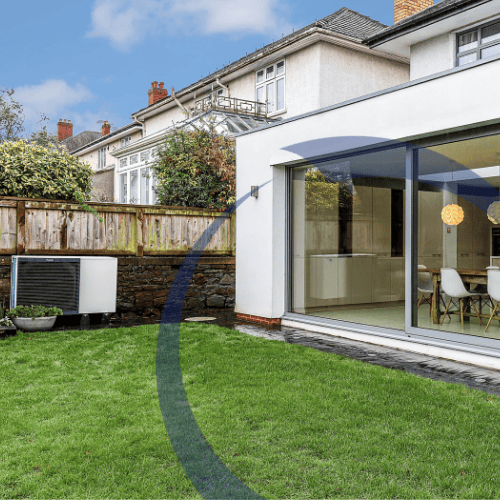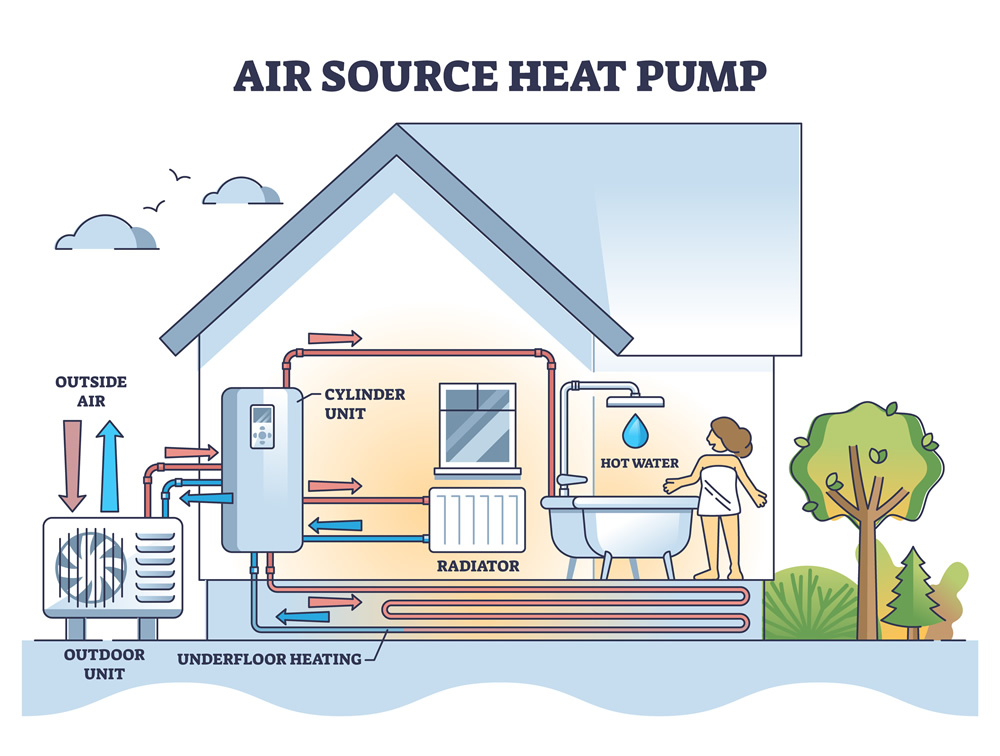How do air source heat pumps work and what are they? A comprehensive guide
As energy costs rise and environmental concerns grow, heat pumps are revolutionising home heating systems across the UK. These sustainable alternatives to traditional wood, gas, and oil systems offer remarkable efficiency without combustion. But how exactly do heat pumps work? Let’s explore the fascinating world of heat pumps.
What are heat pumps and what different types are available

What is a heat pump?
A heat pump is a device that transfers heat from one source location (soil, water or air) to another location, such as the radiators in your home. They run on electricity and are up to 300% more efficient than a traditional boiler as the amount of heat produced is much higher than the energy consumed.
Air source heat pumps use the principles of vapour compression to generate heat. They use outdoor air to produce heat for your home. Air source heat pumps consist of 4 major elements that allow the refrigerant to pass from the liquid form to gas: a compressor, a condenser, an expansion valve, and an evaporator.
When the refrigerant passes through the system, it absorbs the heat from the outside air. Then, the compressor increases the heat by increasing the pressure. In the condenser, this higher temperature heat is transferred to the heating and hot-water circuits of your home. After that, the medium temperature liquid flows into the expansion valve where upon the release of pressure, its temperature also drops. Finally, the now cooled down liquid is returned to absorb more heat from the air and repeat the process.
ASHPs can be used for heating water for domestic use, radiators, and underfloor heating. Such systems are called air-to-water heat pumps. If suddenly a large amount of hot water is needed, they are also equipped with an electrical resistance heating element that would supply additional heated water (at a lower efficiency rate, though).
Alternatively, air source systems can be used for heating and cooling the indoors air using air-to-air heat pumps. These work similarly to an air conditioning unit but can both heat and cool the house efficiently, adding tot he list of benefits of air-to-air systems.
The basic principles of air source heat pumps
So let’s start with looking at how heat pumps in general work, as ‘air source’ heat pumps are just one kind out of the few varieties.
You may already know that energy is never created or lost, but simply moved. When heating your home using something like a wood burner, fireplace, or a gas/oil boiler, you’re relying on the energy stored in those materials for the heat.
Put simply, a tree grows by capturing energy from the sun and absorbing carbon from its environment. That energy gets stored in the wood until it is cut down and used for firewood.
If that tree grew millions (or billions) of years ago and fell down in the right conditions, that stored energy could have condensed even further into coal, crude oil or natural gas. So these forms of heating work by releasing that stored energy through combustion.
But, as we’re seeing with the accelerating rate of climate change, releasing so much of that energy stored in wood, coal, gas and oil is creating real problems for environments around the world.
Heat pumps, on the other hand, don’t need to combust anything – they’re not a source of energy in themselves but simply move energy from one place to another.
But heating your home is clearly not as simple as pulling in air from outside in the depths of winter – you’d then just have a cold house! The question, then, is where do heat pumps move energy from.
How heat pumps work
Unlike traditional heating systems that generate heat through combustions, heat pumps simply transfer existing energy from one place to another. This fundamental difference is why they’re so efficient.
Traditional heating works by releasing energy stored in materials like wood, coal, or gas through combustion. These materials essentially contain captured solar energy – whether from trees that grew recently, or fossil fuels formed millions of years ago.
Heat pumps, by contrast, don’t create heat – they move it. This process can achieve over 400% efficiency, meaning 1kW of electricity can produce more than 4kW of heat. Here’s how the cycle works:
- A refrigerant circulates through an evaporator (similar to a car radiator)
- A fan draws air across the evaporator, transferring energy to the refrigerant
- This energy causes the refrigerant to boil and turn into vapour
- The vapour is compressed, which generates heat
- The hot vapour passes through a condenser, transferring heat to your home’s water circulation system
- The refrigerant then passes through an expansion valve, cooling it down for the cycle to begin again
-

How heat pumps work in cold weather
You might wonder how heat pumps extract warmth when outside temperatures drop below freezing. The answer lies in clever engineering:
- Heat pumps use refrigerants that remain liquid well below 0°C
- Even cold air contains thermal energy that can be extracted
- The compression process significantly amplifies available heat
- As long as the refrigerant is colder than the outside air, heat will transfer naturally
Choosing the right heat pump
Heat pumps can extract energy from three main sources: ground, water, and air. Each has distinct advantages for different situations.
Ground source heat pumps
These systems extract heat from the ground via buried pipes filled with a water-antifreeze mixture. The pipes are installed either through deep boreholes or in shallow trenches with coiled “slinky” pipes.

Advantages:
- Excellent for stable ground temperatures
- Minimal maintenance requirements
- Consistent performance
Disadvantages:
- High installation costs for drilling and excavation
- Not suitable for all terrain types
- Limited by available land space
Water source heat pumps
Instead of soil, these systems extract heat from water sources like aquifers, lakes, or rivers. They can use either closed loops (pipes) or open systems that draw water directly.

Advantages:
- More consistent temperatures than ground systems
- Less affected by seasonal changes
- Highly efficient when properly installed
Disadvantages:
- Higher installation and maintenance costs
- Limited suitable locations
- Potential environmental concerns with water extraction
Air source heat pumps
These increasingly popular systems extract heat directly from outside air. A fan draws air over an evaporator coil containing refrigerant.

Advantages:
- Significantly lower installation costs
- No excavation required
- Compatible with existing central heating systems
- Easy maintenance access
- Can run entirely on renewable energy
- 20+ year operational life
Disadvantages:
- May require more electricity during extreme weather
- Performance depends on quality of installation
- Slightly less efficient than ground/water systems in very cold weather
Air-to-air vs air-to-water heat pumps
Once heat is extracted, it needs to be distributed throughout your home. This happens in one of two ways:
Air-to-air heat pumps
These systems heat air directly and distribute it through ducts or individual room units. While common in commercial settings and countries with hot summers, they’re less popular in UK homes because:
- Most UK homes have limited cooling needs
- They’re less energy-efficient overall
- Retrofitting homes with existing water-based systems is expensive
- Heated air can create dry, uncomfortable environments
- They can’t heat water for taps and showers
Air-to-water heat pumps
These systems connect to your existing central heating and hot water systems, making them ideal for UK homes. They offer:
- Easy integration with existing radiators and pipes
- Minimal home modifications required
- Advanced temperature control for consistent comfort
- Combined space heating and hot water
- Weather-dependent operation for maximum efficiency
Modern air-to-water systems can maintain consistent temperatures rather than cycling on and off, providing more comfortable heating while using less energy.
Making the switch to heat pump technology
When considering a heat pump installation, expertise matters. Choose qualified installers with experience in heat pump technology to ensure proper system sizing and efficient operation.
Air source heat pumps represent an accessible entry point for most UK homeowners looking to transition to sustainable heating. With proper installation, they provide reliable, efficient heating year-round while significantly reducing your carbon footprint.
As electricity grids continue to incorporate more renewable energy, heat pumps become an increasingly sustainable choice for environmentally conscious homeowners.


